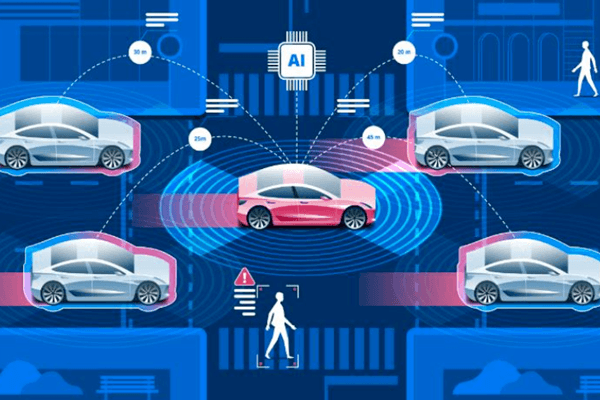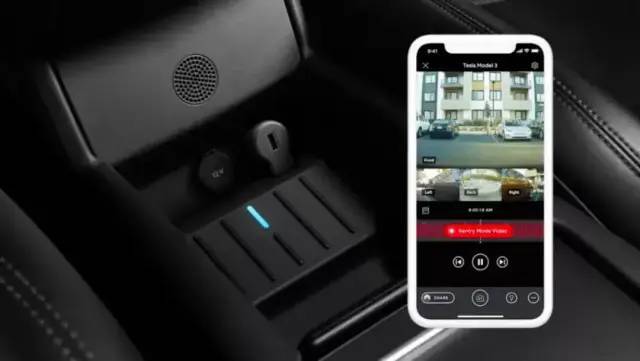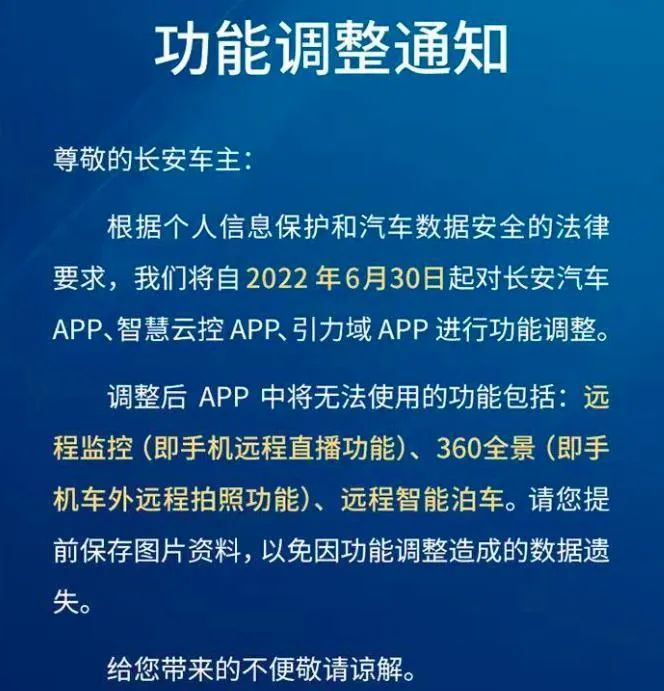Why did Changan turn off the photo function outside the car?
The border is drawn, once the barbaric growth of a variety of cameras, radar can not just open and collect information.

Recently, Changan Automobile officially issued a function adjustment notice, "according to the legal requirements of personal information and car data security", from June 30 to close the remote monitoring, 360 panoramas, and remote intelligent parking function.

Changan Auto function adjustment announcement
In fact, Changan is considered to be "late" in closing.
NECTAR has learned that a number of new car makers, including XPENG, and a number of Chinese car companies, including BYD, have taken down the remote access to their exterior cameras. Even Tesla, the inventor of the feature, has turned off "Sentry Mode" in China.

In other words, the user's ability to view/save directly from outside the car, the various raw data collected by the vehicle's external sensors, is beginning to be restricted.
01
Compliance Requirements
Tesla's Sentry feature, which allows cell phones to remotely monitor the situation outside the car
"Compliance" is of course the direct reason.
In August 2021, the "Automotive Data Security Management Provisions (for Trial Implementation)" (hereinafter referred to as the "Trial Provisions") were jointly announced by the State Internet Information Office, the Development and Reform Commission, the Ministry of Industry and Information Technology, the Ministry of Public Security, and the Ministry of Transportation, and came into effect on October 1, 2021.

The Trial Provisions mainly define the data collection, transmission, and use inside and outside the car from three aspects: in-car cabin data, sensitive data such as face/license plate outside the car, and personal privacy notification, and delineate the responsibilities and powers of car data processors.
Among them, for remote monitoring/photography/parking which will involve the part of the car outside data, "trial provisions" requirements: car data processor should obtain the consent of the individual or other circumstances in line with the provisions of laws and administrative regulations.
That is if the photo/camera needs to obtain the consent of the collection of individuals outside the car, the vehicle owner.
And if the need to ensure driving safety can not obtain consent, and to provide outside the car, "should be anonymized, including the deletion of the picture containing the ability to identify natural persons, or the picture of the face information, such as local contouring."
That is if the owner of the car is in the process of driving a casual shot, or remote monitoring / remote control of the vehicle, see the outside of the car license plate/face, etc. should have been blurred, and another desensitization process, not easily recognizable images.
And it is worth noting that the "Trial Regulations" advocate the four elements that automotive data processors adhere to in carrying out automotive data processing activities including: "the principle of in-vehicle processing unless it is really necessary not to provide outside the vehicle."
That is, under non-essential conditions, data collected by the vehicle is to be made available outside the vehicle after the desensitization process is completed inside the vehicle.
The previous hardware arithmetic and software arrangement on the vehicle side is based on reasoning and execution, focusing on the output of the results (images, sounds, driving actions displayed in the cockpit). The data processing work like image blurring is left to the cloud server outside the vehicle.
02
How much is the cost of compliance?
The recognition of images outside the car, coupled with the requirement to complete information desensitization at the end of the car, may become the fundamental reason for Changan and other car companies to shelve the function: the reconsideration between compliance costs and functional benefits.
Considering that smartphones can directly realize the function of background bokeh on the cell phone, there is no great obstacle for car companies to achieve compliance technically.
Outside the car portrait desensitization (schematic)
Technical expert A Bao 1900 told CHNECAR that to achieve compliance, vehicles need some upgrades at the software and hardware level.
At the software level, the difficulty of the algorithm to identify and process the sensitive information within the image is not high. Just before the car companies more than not in this field layout, need a certain development and testing cycle, or 2-3 months, can be landed through the OTA online upgrade of the car end.
But the premise is that the hardware arithmetic power is enough.
The chip arithmetic power of the camera side can not support the recognition of the picture / fuzzy processing requirements, and generally need domain control at this level of chip processing, mostly in the cockpit area. A Bao 1990 estimates that the current mainstream high-end adaptation of Qualcomm 8155 (4TOPS) and other high arithmetic power cockpit chips may be able to support the completion of the desensitization process in the car end.
However, models such as the Qualcomm 820A, which does not support AI acceleration chips, are required to meet the vehicle-side processing to upgrade the platform level of the domain controller, and the overall hardware cost maybe $1000/vehicle, as well as a year of development verification time.
In addition, whether the image is eventually desensitized in the cloud or on the vehicle side, it mAIONs goodbye to real-time for consumers.
Even with a high-calculus chip on the vehicle side, the algorithm still requires a delay of a few seconds to process the image, and this delay will continue to increase as the camera becomes more HD and the image data becomes more massive.
Obviously, both the time required to achieve the technology, or hardware upgrades to consider the cost, when the moment car companies are unable to complete compliance requirements in the first place, and also the fundamental reason for its first shelf function.
But whether this will be a permanent shelf, but also depends on the effect of the pilot implementation of the regulations, as well as how the economy accounts for the cost of compliance and functional benefits of car companies.
03
What about smart/autonomous driving?
Self-driving vehicles require massive data collection and sharing
Since vehicle owners cannot remotely access cameras outside their vehicles, does that mAION that car companies will also be limited when it comes to intelligent/autonomous driving research and development and feature implementation? After all, do vehicles need the same rich off-vehicle data collection on the road in order to achieve the function?
Currently, some domestic scholars believe that the Pilot Regulations do not dovetail well with the need for data collection for intelligent/autonomous driving functions. This is because massive data collection and extensive data sharing are required to achieve functionality. Meeting the requirements of the Trial Regulations under this premise would be very difficult and contrary to the laws of industry development.
In practice, CHNECAR has learned that when it comes to data collection for the implementation of intelligent/autonomous driving functions, car companies currently mostly use internal strict data security specifications for protection.
This includes data security hardware modules on the vehicle side, hardware isolation in uploading and storage, and setting up a data usage specification system to ensure that data is used for capability enhancement and function realization of intelligent/autonomous driving systems within a range that is knowable and controllable by the enterprise.
Overall, although China already has a relatively complete system of laws and regulations on network security, data security, and personal information protection. However, data collection for intelligent/autonomous driving function realization is currently being done in a gradual and process-oriented manner in China.
During the industrialization process, the types and scope of data required for the safe operation of intelligent/autonomous vehicles are being explored, so that they can be effectively controlled to the extent required by the "minimum necessary" principle.
At the national level, the "Data Format and Definition for Intelligent Networked Vehicles" developed by the China Association of Automobile Manufacturers, and the "Requirements and Methods for Intelligent Networked Vehicle Scene Data Labeling" and "Requirements and Methods for Intelligent Networked Vehicle LIDAR Point Cloud Data Labeling" developed by the Chinese Society of Automotive Engineering have been released.
At the local level, the "Shenzhen Special Economic Zone Regulations on the Management of Intelligent Networked Vehicles" (hereinafter referred to as Shenzhen Regulations) have entered the 2022 legislative plan of the Standing Committee of the Shenzhen People's Congress and have passed the third review stage before its release, which is only one step away from its official introduction.
If finally released, the "Shenzhen Regulations" will become the first official document to carefully regulate the rights and responsibilities of L3 and above autonomous driving, data management, and other issues, and may promote Shenzhen to become the first city in China to release L3 and higher-level autonomous driving features. This will further accelerate China's active exploration in the application of intelligent/autonomous driving technology on the ground.
As cars really gradually become robots in the real world, we all stand at a border of the future that we have never reached before. How do define the functional boundaries of smart cars so that they can become service providers rather than aggressors and truly fit in with human society? The wisdom of legislators and practitioners will be tested for a long time.
Reference.
Data Governance: A Must for Self-Driving Cars on the Road, Professor Zheng Ge, Kaiyuan Law School, Shanghai Jiao Tong University







